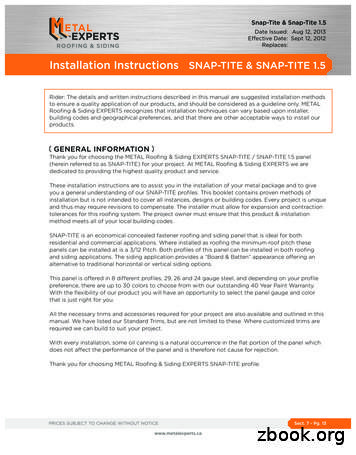Snap-3D: A Constrained Placement- Driven Physical Design .
Snap-3D: A Constrained PlacementDriven Physical Design Methodologyfor Face-to-Face-Bonded 3D ICsPruek Vanna-iampikul, Chengjia Shao, Yi-Chen Lu,Sai Pentapati, and Sung Kyu LimGeorgia Institute of Technology
Contents Pseudo-3D vs. True-3D physical design flows Snap-3D flow– Overview– Details– Strengths Experimental Results Conclusions2/16
Heterogenous Integration Technologies2.5D interposermicro bumpingTSMC CoWoSIntel Foverosmonolithic 3Dhybrid bondingcoming soonTSMC SoIC, Samsung X-cube3/16
Pseudo-3D vs. True-3D EDA Toolscircuit4/161true-3Dplace/route2commercial tool NOT e 2D (commercial tool READY)final 3D
Snap-3D: Overview5/16
Snap-3D: Design Flow Goal– Use EDA vendor tools as much as possible– Then add key missing engines and seamlessly integrate6/16
Our Automatic Tier Partitioner7/16 Bin-based hypergraph partitioning– Divide 2D into bins, and partition each bin– Bi-partitioning engine is Fiduccia-Matheyses algorithm [1982]intermediate 2Dhypergraph modelbucket sorting of “gain”Why binning? Bin size determines F2F usage!
Snap-3D: Key Benefit (1/2)8/16 Commercial placement quality– 2D placement preserved in 3D placement!aabb cdSnap-3D placementcdtop tier placementbottom tier placement
Snap-3D: Key Benefit (2/2)9/16 Commercial routingquality– We route both tierssimultaneously withdouble metal stack– This allows metal layersharing!connecting cellsin the bottom tierconnecting cellsin the top tier!!!M5 BottomM6 Bottom
Snap-3D: Placement Sample10/16
Handling Memory Macros Memory macros are used in processor designs– Mostly placed manually: become placement blockages in Snap-3D– If both tiers are blocked: gate placement not allowed– If one tier is blocked: corresponding rows are not used11/16
Full-Chip GDS Layouts12/16 Snap-3D using TSMC 28nm– Not just placement: does routing, timing closure, and PPA simulations– High-quality layouts: OUTPERFORMS COMMECIAL 2D PPACortex A53 2D vs. 3DTATE 2D vs. 3DCortex A7 2D vs. 3DAES 128 2D vs. 3DRocketCore 2D vs. 3DLDPC 2D vs. 3D
A53 Full-Chip PPA13/162DInnovusShrunk2D [2]target freq (GHz)footprint (mm2)Compact2D [3]Snap-3Dsame1.00.50.50.5-1.01.011.15wirelength (m)1.00.690.700.73power (mW)1.00.670.660.67WNS (ns)1.00.571.120.33power delay2.101.121.460.97# F2F padsInnovus 2D full-chip GDS, A53Snap-3D full-chip GDS, A53
A53 Memory Latency/Energy Shorter WL in 3D– Helps reduce memoryaccess latency and power!metric14/162D3D3D gainEnergy/cycle (pJ)3.732.5730.8Input latency (max, ps)2092023.4Input latency (ave, ps)704437.1Output latency (max, ps)27212554.0Output latency (ave, ps)572850.9
Clock Comparison : AES @ 28nm2DInnovusShrunk2D [2]Compact2D [3]Snap-3D211.8181.5177.6166.1Clock Skew (ps)9.911.711.38.5Clock WL. (mm)43.4242.1541.3338.99# Clk. F2F pads0674671731875910849862Clock MetricsClock Latency (ps)# Clock Bufferclock tree for AES, 2D Innovusclock tree for AES, Snap-3D15/16
Conclusions Snap-3D key ideas– Use half heights (for cells and rows)– Do tier partitioning first and snap cells to rows ( constrained placement)– Use double metal stack for routing Snap-3D key benefits– 2D placement 3D placement– Metal layer borrowing is supported– Outperforms Innovus 2D, Shrunk-2D [2] and Compact-2D [3]16/16
Snap-3D key ideas – Use half heights (for cells and rows) – Do tier partitioning first and snap cells to rows ( constrained placement) – Use double metal stack for routing Snap-3D key benefits – 2D placement 3D placement – Metal layer borrowing is supported – Outperforms Innovus 2D, Shrunk-2D [2] and Compact-2D [3 .
Table of Contents Sequence strong List /strong . Unit 0 1 Introduction 2 How to take the placement tests 3 Placement Test I 4 Placement Test II 5 Placement Test III 6 Placement Test IV 7 Placement Test V 8 Placement Test VI 9 Placement Test VII 10 Placement Test VIII 11 Placement Test IX 12 Placement Test X
Table of Contents Sequence strong List /strong . 50-090816 Unit 0 1 Introduction 2 How to take the placement tests 3 Placement Test I 4 Placement Test II 5 Placement Test III 6 Placement Test IV 7 Placement Test V 8 Placement Test VI 9 Placement Test VII 10 Placement Test VIII 11 Placement Test IX
SNAP-TITE 1.5 Installation Instructions SNAP-TITE & SNAP-TITE 1.5 Snap-Tite & Snap-Tite 1.5 Date issued: aug 12, 2013 effective Date: sept 12, 2012 replaces: www.metalexperts.ca Prices subject to change without notice Sect. 7 - Pg. 16 ordErINg roofINg or SIdINg PANElS
The Cat in the Hat (Tune: The Adams Family) The cat in the hat (snap! snap!) The cat in the hat (snap! snap)! The cat in the hat The cat in the hat The cat in the hat (snap! snap!) He causes so much fun But when the fun is done You will be the one To send that cat AWAY! Repeat chorus.
5 APPLICATION MATRIX Amphenolrf.com AFI 6 GHz 50 & 75 Ohm Snap-On AFI-Dart 18 GHz 50 & 75 Ohm Snap-On AMC 6 GHz 50 Ohm Snap-On AMMC 6 GHz 50 Ohm Snap-On BNC 11 GHz 50 & 75 Ohm Bayonet FAKRA 4 GHz 50 Ohm Snap-On HD-BNC 6 GHz 50 & 75 Ohm Bayonet HD-EFI* 6 GHz 50 Ohm Push-Pull MCX 6 GHz 50 & 75 Ohm Snap-On
6. SNAP-Ed is enhanced when the specific roles and responsibilities of local, State, regional, and national SNAP agencies and SNAP-Ed providers are defined and put into practice. The Focus of SNAP-Ed at the Michigan Fitness Foundation . The Michigan Fitness Foundation (MFF) requests that SNAP-Ed programs focus on two of the USDA's
Welcome to the Snap Inc. Code of Conduct! You may be wondering at the outset: Why does Snap Inc. (“Snap”) have a Code of Conduct, and do I really have to read it? The answer to the second question is, emphatically, yes. As a member of the Snap team, reading and understanding this Code is a critical requirement of your job.
Super Locrian is often used in jazz over an Altered Dominant chord (b9, #9, b5, #5, #11, b13) Melodic Minor w h w, w w w h 1 w 2 h b3 w 4 w 5 w 6























